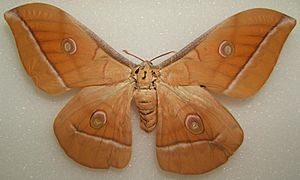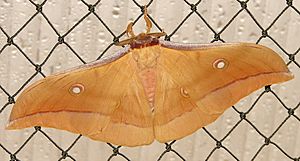Chinese (oak) tussar moth facts for kids
Quick facts for kids Chinese (oak) tussar moth |
|
|---|---|
 |
|
| Mounted female | |
 |
|
| Living specimen | |
| Scientific classification | |
| Synonyms | |
|
The Chinese tussar moth (also known as the Chinese oak tussar moth or temperate tussar moth) is a very large moth. Its scientific name is Antheraea pernyi. This moth belongs to a group of moths called Saturniidae, which are known for their big size. Félix Édouard Guérin-Méneville first described this species in 1855.
These moths originally came from southern China. They are famous for making a special kind of silk called tussar silk. Because of this, people have moved them to many places across subtropical and tropical Asia. Unlike the domestic silk moth, which needs humans to survive, tussar moths can live on their own if they escape. Sometimes, you might find small groups of these moths living wild. The color and quality of the silk they produce can change depending on the weather and soil where they live.
This moth is one of the main sources of tussar silk. It was very important for trade during ancient times in China, like the Han Dynasty (around 200 BC to 250 AD). More recently, a new type of moth called Antheraea × proylei is being raised for tussar silk. This new moth is a hybrid, meaning it's a mix of a male A. pernyi and a female Antheraea roylei. Interestingly, this hybrid moth gets its special cell energy parts (called mitochondrial DNA) mostly from the father, which is unusual! In China, these silkworms are raised on special farms where they eat leaves from trimmed oak trees on hillsides.
How the Moth Fights Germs
Scientists have studied how the Chinese tussar moth fights off germs, like bacteria. When bacteria (like Escherichia coli) get into the moth's body, its immune system kicks in. The moth's blood, called hemolymph, contains special proteins that act like tiny soldiers. These proteins include things like cecropin, hemolin, attacin, and lysozyme. They help to destroy the invading bacteria.
When the moth gets an infection, it also produces more of a special protein called a lectin. This lectin helps the moth's body to recognize and clump together foreign invaders. The Chinese tussar moth has also been used in research to understand how insects defend themselves against viruses. Scientists found that a protein called hemolin helps the moth fight off viruses, and it can also be activated by certain types of genetic material.
Gallery
-
First-instar caterpillars









